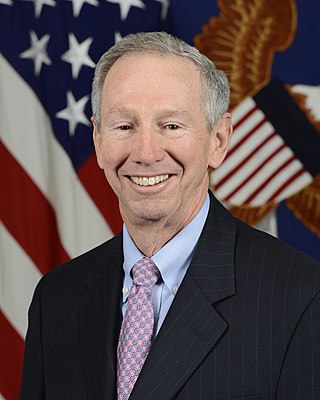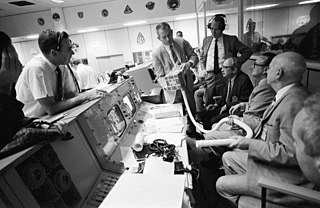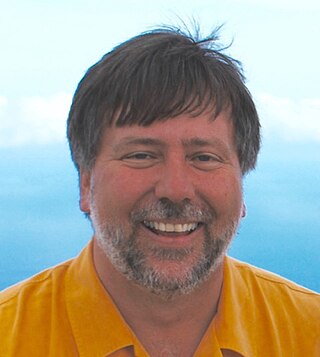
Spacecraft propulsion is any method used to accelerate spacecraft and artificial satellites. In-space propulsion exclusively deals with propulsion systems used in the vacuum of space and should not be confused with space launch or atmospheric entry.

The Goddard Space Flight Center (GSFC) is a major NASA space research laboratory located approximately 6.5 miles (10.5 km) northeast of Washington, D.C., in Greenbelt, Maryland, United States. Established on May 1, 1959 as NASA's first space flight center, GSFC employs about 10,000 civil servants and contractors. Named for American rocket propulsion pioneer Robert H. Goddard, it is one of ten major NASA field centers. GSFC is partially within the former Goddard census-designated place; it has a Greenbelt mailing address.

The Italian Space Agency is a government agency established in 1988 to fund, regulate and coordinate space exploration activities in Italy. The agency cooperates with numerous national and international entities who are active in aerospace research and technology.
Micro-Space was an aerospace corporation based in Denver, Colorado, founded in February 1977 by Richard P. Speck under the name Spectron Instrument Corporation. The corporation changed its name to "Micro-Space, Inc." in 1998. It was dissolved in 2011, following the death of the founder.

Michael Douglas Griffin is an American physicist and aerospace engineer who served as the Under Secretary of Defense for Research and Engineering from 2018 to 2020. He previously served as Deputy of Technology for the Strategic Defense Initiative, and as Administrator of NASA from April 13, 2005, to January 20, 2009. As NASA Administrator Griffin oversaw such areas as private spaceflight, future human spaceflight to Mars, and the fate of the Hubble telescope.

Sol Alan Stern is an American engineer, planetary scientist and space tourist. He is the principal investigator of the New Horizons mission to Pluto and the Chief Scientist at Moon Express.

Bahir Dar University [BDU] is a public research university in Bahir Dar, capital of the Amhara Region, Ethiopia. The university, with two institutes in diploma programs until 1966, is credited to training distinguished scientists and notable public servants. BDU began offering bachelor degree programs in 1966 and continues to expand its research and teaching in all fields and levels of study, including PhD programs. The official slogan of the university is "Wisdom at the source of the Blue Nile". Currently the university has five colleges, four institutes, seven faculties, two academies, and two schools.
Jerome Pearson was an American engineer and space scientist best known for his work on space elevators, including a lunar space elevator. He was president of STAR, Inc., and has developed aircraft and spacecraft technology for the United States Air Force, DARPA, and NASA. He held several patents and was the author of nearly 100 publications in aircraft, spacecraft, electrodynamic tethers, SETI, and global climate control.

Goddard Space Flight Center (GSFC) is NASA's first, and oldest, space center. It is named after Robert H. Goddard, the father of modern rocketry. Throughout its history, the center has managed, developed, and operated many notable missions, including the Cosmic Background Explorer, the Hubble Space Telescope, the Tracking and Data Relay Satellite System (TDRSS), the Lunar Reconnaissance Orbiter, and the Solar Dynamics Observatory.

Aerospace engineering is the primary field of engineering concerned with the development of aircraft and spacecraft. It has two major and overlapping branches: aeronautical engineering and astronautical engineering. Avionics engineering is similar, but deals with the electronics side of aerospace engineering.
Dr. Salim Mehmud, also known as Salim Mehmood, is a Pakistani rocket scientist and a nuclear engineer. Mehmud worked in the Apollo Program for NASA. He is the former chairman of Space and Upper Atmosphere Research Commission (SUPARCO). He has served as chief scientist at the Defence Science and Technology Organization. Currently, he is the chief Scientific and Technological Advisor at the Ministry of Communications of Pakistan.

Robert David Braun is an American aerospace engineer and academic. He has served as the dean of the College of Engineering and Applied Science at the University of Colorado Boulder, the David and Andrew Lewis Professor of Space Technology at the Georgia Institute of Technology, and the NASA Chief Technologist. Currently, Dr. Braun is the Space Sector Head at the Johns Hopkins University Applied Physics Laboratory (APL).
The National Institute of Aerospace (NIA) is a non-profit research and graduate education institute headquartered in Hampton, Virginia, near NASA's Langley Research Center.
Yvonne Madelaine Brill was a Canadian American rocket and jet propulsion engineer. She is responsible for inventing the Electrothermal Hydrazine Thruster (EHT/Resistojet), a fuel-efficient rocket thruster that keeps today’s satellites in orbit, and holds a patent for its invention. During her career she was involved in a broad range of national space programs in the United States, including NASA and the International Maritime Satellite Organization.

David A. Spencer is the Mars Sample Return Campaign Mission Manager at the Jet Propulsion Laboratory. As an aerospace engineer, Spencer designs and operates planetary spacecraft.

Jim Cantrell is an American entrepreneur, mechanical engineer and road racer. He is the CEO and co-founder of Phantom Space Corporation, which aims to build space transportation technology. After working at the French Space Agency CNES and the NASA Jet Propulsion Lab, he worked as an independent consultant to aerospace companies for fifteen years and was on the founding teams of SpaceX and Moon Express. Cantrell was a consultant for SpaceX and Elon Musk's industry mentor when SpaceX launched in 2002.

David Y. Oh is an American spacecraft systems engineer and expert in electric propulsion. Dr. Oh currently works at the Jet Propulsion Laboratory (JPL) as the NASA Psyche mission chief engineer. Prior to this role he served as the Project Systems Engineering Manager for Psyche. He was also the cross-cutting phase lead and lead flight director for the NASA Mars Science Laboratory mission and was recognized in popular media for living on Mars time with his family during the month following the landing of the Curiosity rover.











